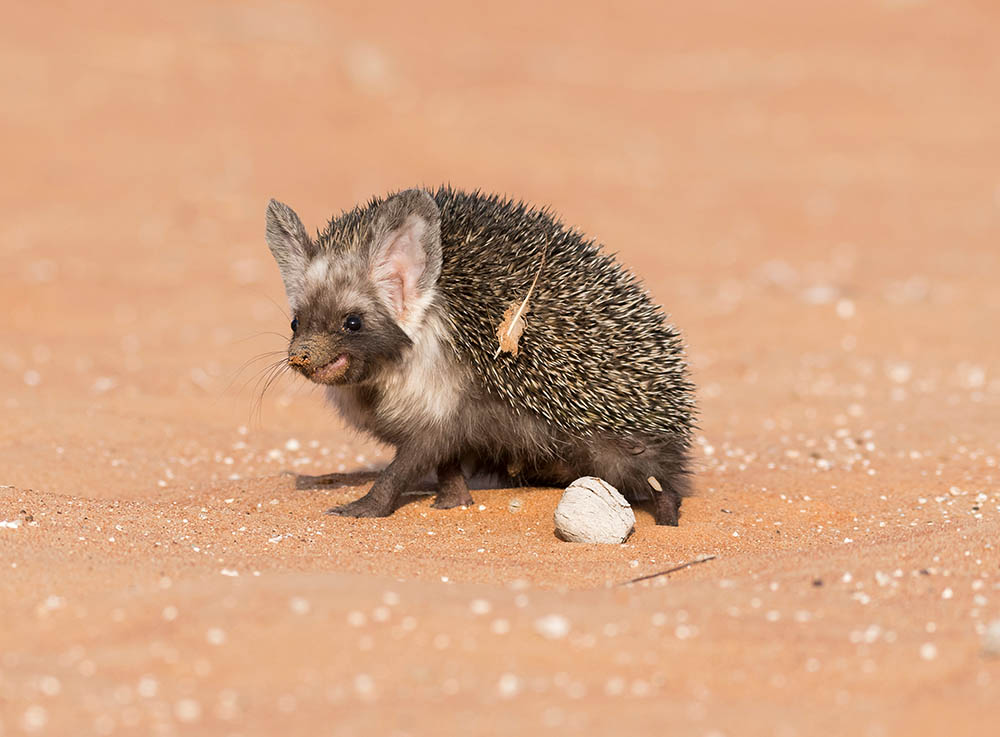Hedgehogs, we all know them and love them. These amazing little critters are often found in our back garden, rooting around dead leaves and compost for bugs and other delicious insect treats.
But you might not have heard about the common hedgehog’s cousin: the Desert Hedgehog.

These types of hedgehogs really thrive in the wild, especially in tough desert conditions, which are known to be very arid. This hedgehog usually lives around 3-4 years and, despite human beings slowly encroaching upon their territory, they have maintained a stable population.
The chances of you finding these hedgehogs is a lot rarer than the ones in your backyard.
They can be mainly found in North Africa and the Middle East, often gravitating to oases or vegetable wadis in the desert where nutrition is a little richer.
This little critter is probably one of the most adaptive creatures that you can find out there, surviving on very little resources and populating their area without enough fellow hedgehogs to protect themselves from all the predators in the area (although we’ll talk about this a lot more later on).
So where can you find a desert hedgehog? What makes them so different from regular hedgehogs?
What do they eat and how exactly do they survive in such desolate conditions? How do they evade predators and what about their physiology makes them so tenacious?
Well, if you are curious about this little hedgehog, then you’ve come to the right place.
This article will cover everything about the desert hedgehog’s weekly movements, from mating, to foraging to hiding out for the winter. But at the end of this article, you should have enough facts to consider yourself a desert hedgehog expert.
Where Can You Find The Desert Hedgehog?
The desert hedgehog can often be found hanging around the Arabian peninsula, as well as North Africa.
It likes hot and dry conditions, so you can find it mooching around countries like Egypt, Sudan, Eritrea and Morocco. You can also find them in the Middle East as well as some of the Canary Islands.
The desert hedgehog lives in arid terrain and can often be found on the outskirts of certain desert villages, seeking shelter in desert steppes. Like most mammals of this kind, it is constantly seeking out vegetation and insects, which can actually be found in the desert.
Many desert vegetables contain enough water and nutrients for the desert hedgehog to thrive.
If you head to an oasis in the desert, where there’s water and some vegetation, don’t be surprised if you’ll find some desert hedgehogs poking their noses in certain areas. You can also find the desert hedgehog in wooded areas, such as gardens and other cultivated areas.
An oasis in the desert is an area of fertile vegetation, where you can often find a whole host of animals, including camels, elephants and plenty of insects.
The hedgehog comes here when it needs feeding and will often breed in these areas, as it will be a meeting place for lots of other desert mammals.
What Habitat Does A Desert Hedgehog Prefer?
These desert hedgehogs often prefer their own company, coming out at night when they can be left alone.
During the daytime, they can be found near rocks and cliffs, which affords them protection from airborne predators like vultures and crows.
When the temperatures in the desert cool, then that is when these animals tend to hibernate.

One of the reasons for this is that the food that the hedgehogs thrive off, such as vegetation and little insects, becomes a lot more scarce during this time. This way they can preserve their energy, storing food as fat.
A desert hedgehog will usually hibernate during the months of January and February. They will also become less active when the temperature gets too hot, seeking shade and shelter where they can.
In the wild, these hedgehogs do not always behave like some of their other cousins in other parts of the world.
Whereas the common hedgehog might curl into a ball when it is being attacked by a predator, the desert hedgehog will usually try and make a run for it first. They will only resort to curling up into a spiky ball if they cannot escape.
They also use their environment as a cover for predators. In the daytime, you can expect to find desert hedgehogs keeping out of the light of the sun in dry rocks or cliff faces. This also keeps them out of the sight of birds of prey, then often use the sun to pick them off and attack them.
What Does A Desert Hedgehog Look Like?
The desert hedgehog has the classic dorsal spines that cover the back.
They are generally bald on the head and have much longer, pointier ears than other breeds of hedgehogs. These desert hedgehog’s spines are often hollow, often coming in a pale brown color with much darker tips.
The color of the desert hedgehog’s muzzle is dark brown with lighter bands around the forehead. The underside of the desert hedgehog can vary wildly in color, from brown to black to mottled white to solid white.
There is a similar breed of hedgehog that is slightly larger which has similar markings. The only way you’ll be able to tell these hedgehogs apart is the difference in size. They will often be found together in similar areas.
How Does The Desert Hedgehog Reproduce?
The desert hedgehog will start breeding around March, once it has come out of hibernation.
They give birth to around 6 young per burrow, which is a nest hidden in a crook or a cliff face. The gestation period for baby desert hedgehogs will be around 30 to 40 days.
The young of a desert hedgehog are usually born blind and deaf, with spines just below the skin that will protrude after they have been born. This is done so that the baby hedgehogs will not damage the mother upon birth.
Once they have been born, the spines will start to emerge within a few hours.
The adult hedgehog will then wean the young on her milk from 40 days old. Sadly, not all of the young have been known to survive to adolescence, some babies even die during birth.
If the young die in childbirth, then the mother has been known to cannibalize her children to give herself sustenance. This will also happen when food is very scarce.
How Large Is The Desert Hedgehog Population?
Thankfully, the desert hedgehogs are not considered to be an endangered species.
However, with conditions in the desert becoming way arider, the biological productivity of their habitats is starting to decline incrementally. This leads to skeletal soil that cannot be recovered in the same way as verdant land.
The desert hedgehog might also succumb to increased deaths if it is living near roads. The cause of death by traffic is becoming increasingly popular, with scientists observing that 1 in 10 hedgehogs die from traffic accidents.
The population of the desert hedgehog is largely concentrated in the Sahara desert and the Middle East, although not actual numbers have yet to be determined.
However, scientists have determined that the numbers of the hedgehog have not been in decline and have remained stable since studies have been conducted.
How Long Does The Desert Hedgehog Live?
On average, a desert hedgehog will live for around 3-4 years, although there have been some studies that have shown that they can last for up to 10 years. In captivity, a hedgehog lasts around 4.5 years, on average.
Studies are still inconclusive when it comes to the maximum life expectancy of a desert hedgehog.

As mentioned above, some baby hedgehogs will not live until adolescence.
The chances of a baby hedgehog dying during this time are much more increased if food is scarce and the mother has not eaten enough to keep her children adequately sustained throughout pregnancy.
Often the female hedgehog has been known to ingest her babies if food is scarce during the childbirth stage.
If you have desert hedgehogs in captivity, then you can avoid this from happening by feeding her milk and separating the female from her children at birth, although this should only be reserved if you think cannibalization is likely.
How Does A Desert Hedgehog Behave?
During the daytime, desert hedgehogs will be found sleeping in their burrows that are nestled in cliffs, away from predators, especially birds of prey.
These hedgehogs differ from their more common European cousins, as they will sleep on their sides as their spines offer them little protection from birds and other predators.
These hedgehogs will usually hunt and start to move around at night, often on their own.
They often hunt prey near an oasis or in the vicinity of vegetation. This is where insects and other small creatures that they feed on will be in abundance.
When the seasons start to get colder, these hedgehogs will hibernate, waking up only periodically to give themselves food and other little treats to keep them going until the weather starts warming up.
Another reason why these desert hedgehogs might hibernate is that their spines do not offer adequate protection against the cold weather. Other breeds of hedgehog can remedy this by curling up into a ball and warming themselves in harsher climates.
You might hear the phrase ‘motile’ when studying hedgehog behavior. This means that these creatures are capable of motion and are often mobile for most of the time throughout the year.
What Does A Desert Hedgehog Eat?
The desert hedgehog dines largely on insects, although owing to the harshness of the climate and the scarcity of foods, it has been known to eat vegetation and larger animals. Generally, this hedgehog has not been known to digest plant matter unless absolutely necessary.
This breed of desert hedgehog has a larger tolerance for snake venom, more so than other types of rodents that are around this size. It can withstand up to 30 or 40 times more venom than a lot of other rodents of this type.
If this hedgehog is hunting stinging or venomous prey, then this will keep it a lot more protected.
Some of the desert hedgehog’s prey includes birds that nest on the ground, frogs, snakes and other smaller amphibians, although these are rarely found outside of oases.
It can also hunt smaller scorpions, with its natural resistance to its stings helping it to attack and eat these creatures.
It has also been known to eat the eggs of smaller ground-nesting birds. This will give it a healthy dose of protein, which will especially come in useful when it is hibernating for the winter.
This hedgehog will generally not attack the birds for their eggs, rather it will wait until the birds have left their nest to go out hunting.
How Does A Desert Hedgehog Escape Predators?
The spines of the desert hedgehog are not as effective against predators as some of the other breeds of hedgehog, so they tend not to rely on this system to stop larger creatures from attacking them.
However, when it does get attacked, it will tuck its head into its ventral region to avoid being hurt.
Its primary predators in the desert are eagles, owls and other birds of prey. It will usually try and run away from these predators, only rolling into a ball if it can find no other means of shelter.
This hedgehog has quite a positive impact on the human environment around it, as it can remove the area of insects and other pests that can damage local vegetation. Some people encourage the spread of hedgehogs in desert communities, often leaving out little bits of meat as treats for them.
These desert hedgehogs usually provide zero harmful impact on the human environment. If you see one nearby, we would recommend approaching it cautiously to observe.
You should avoid touching it as the spines will often hurt a human hand. Make sure dogs and children are kept well away from these hedgehogs.
Other Fun Desert Hedgehog Facts
Here are some fun facts regarding desert hedgehogs, which you can use to teach to children, either as a parent or in a teacher setting.
- These hedgehogs tend to sleep on their side, rather than in a ball that some other species. This is because their spiny shell does not offer much protection against the cold or predators.
- A hedgehog will coat an object it likes in its own saliva, which it then smears across its spines. This is an act that scientists call ‘self anointing and it is currently unexplained.
- Male desert hedgehogs are known as ‘boars’, while females are called ‘sows’. Baby desert hedgehogs are called ‘hoglets’. The collective noun for a desert hedgehog is an ‘array’.
- Desert hedgehogs can consume a wide variety of venomous prey, as they have a naturally higher resistance to stings and other bites than normal hedgehogs. First, they have to bite off the sting of either a scorpion or a snake before they eat the rest of the body.
- Desert hedgehogs can thrive in a climate of around 104 – 108 degrees Fahrenheit. This is why they are often found in more arid climates, favoring shade during the day and coming out only at night. This animal is largely considered nocturnal.
- During the day, desert hedgehogs will often sleep, getting anywhere between 15 and 18 hours of sleep in one stint.
- These hedgehogs are often fully mobile within 40 days of being born. They are weaned by the mother until they are able to move around by themselves.
- Young hoglets are born blind and deaf and will not be able to hear or see for 40 days after they have been born.
- This species is not considered to be endangered and is not very high on the conservation register. This species is known for quite a large and healthy population and has been considered to be stable since numbers started to be monitored.
Our Final Say
We hope that this guide to one of the desert’s most fascinating creatures has whet your appetite to find out more information. If you live in the area that the desert hedgehog is found, then we would recommend going out at night in order to look for it.
If you do spot a desert hedgehog, then we would suggest that you approach it very cautiously, although the chances are that it will either run away or freeze as soon as you get close to it.
Try to keep your dog away from these animals, as if it bites the hedgehog, both creatures might end up with superficial injuries.









